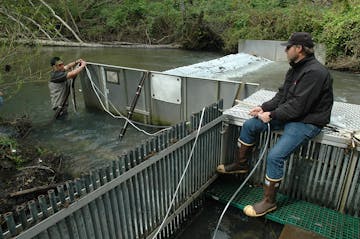Sixty thousand baby coho salmon are released every year into Scott Creek in Northern California. Understanding how many of these fish make it to adulthood has been a tedious job, requiring daily hand counts of returning fish caught in a trap. Now a robotic instrument is gathering data that may revolutionize the way such fish counts are conducted.
For a full year, MBARI’s Environmental Sample Processor (ESP) has collected water samples from Scott Creek, north of Santa Cruz. One to three times a day, water is pumped from the creek up to the ESP where it is filtered; the material collected is preserved to prevent DNA in the water from breaking down. Within that sample are traces of DNA—known as environmental DNA, or eDNA—from tiny particles of skin, mucus, waste, or other matter left behind by animals that live in, or have passed through, the water.

Research Specialist Kevan Yamahara, left, and Mechanical Engineer Doug Pargett secure the hoses that will carry water samples from the fish trap to the ESP. Photo by Kim Fulton-Bennett.
Every 45 days, the instrument is exchanged for a fresh one and the samples are returned to the lab, where Research Specialist Kevan Yamahara carefully extracts the DNA preserved from each sample. Yamahara looks specifically for the presence of coho salmon, as well as other species of interest to stream biologists.

Scott Creek is a particularly interesting location from a conservation perspective. Not only does it represent the southernmost body of water in California to support coho salmon, but it also supports an active run of steelhead trout—another native species of management concern. Scott Creek is at risk of being colonized by two invasive species: striped bass and New Zealand mud snails, which is yet another reason why this coastal stream makes an especially good natural laboratory.
The research is a joint project of MBARI and the Monterey Bay Aquarium, with funding from the Arthur Vining Davis Foundations as part of their newly launched Environmental Engagement, Stewardship & Solutions program. The work is being carried out in collaboration with the National Oceanic and Atmospheric Administration (NOAA). It is part of MBARI’s continuing effort to provide scientific data with direct applications for ocean and wildlife management and conservation.
When analysis is completed in 2020, the eDNA information produced by the project will be the most comprehensive such data set in the world. The eDNA results will be compared with the extensive record available from NOAA’s decades of monitoring this same site. Researchers will use the results to study changes in fish population in a stretch of creek and evaluate whether the population changes over the course of days and months have any relation to the time of release from the hatchery, or other environmental factors.
If the current ESP deployment generates useful data, it could lead to a revolution in fisheries management, both in California and across the US.
